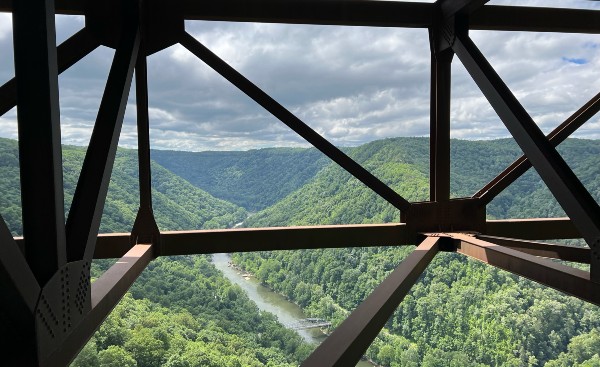
By Susan Jacobson, Class of 2008
It’s the longest single arch bridge in the Western hemisphere and the third longest single arch bridge in the world; it is the New River Gorge Bridge in the New River Gorge National Park, in the heart of the West Virginia mountains.
Designed to reduce a 40 -minute drive down narrow mountain roads to less than a minute, the bridge spans a length of 3,030 feet, with an arch length of 1,700 feet. It rises 876 feet above the New River, making it one of the highest vehicular traffic bridges in the world.

Construction on the bridge began in 1973 and was completed in 1977. It was built by US Steel’s American Bridge Division, the same company that had designed the Bayonne Bridge in New Jersey.
Construction in West Virginia, however, presented some unique challenges.
For one, the slopes of the New River Gorge had been extensively mined for coal from 1890-1930. To ensure that the foundations of the bridge would be firm, hundreds of deep borings were made to check for old mining sites. During this process two enormous voids were discovered. These had to be filled with a mixture of sand and concrete, creating a cone to provide a base for the large concrete footings that support the bridge.

The winding roads of West Virginia presented another challenge. Steel beams could not be transported along the roadways but had to be brought in by railroad cars. Tractor trailers then transported the beams to an assembly area on the gorge’s north side. The heaviest beams had to be brought in by railroad cars and raised up to the top of the gorge with a cable system.
A massive tieback system was constructed to secure the arch in place while it was being assembled. The assembled arms of the arch were built slightly too high; then when the final beam was placed the arms were lowered into place using the tiebacks.
Expansion joints were designed that allow the bridge to rock and sway with the wind and temperature changes. The bridge will shrink in colder weather; at 10 degrees it is 10.5 inches lower than at 60 degrees. The largest joint construction used 2,300 bolts.
The engineers chose COR-TEN steel for the bridge, a material familiar to Chicagoans as this is the same material used for the Daley Center. Economically, this was an excellent choice since COR-TEN produces its own protective rust coating and does not need to be painted. It was also a good aesthetic choice, as the earthy color blends in with mountainous terrain of the gorge.

COR-TEN steel does, however, make inspection more demanding. On a painted steel structure, rust is an indication of cracks and metal fatigue. Inspection of the COR-TEN structure requires that the surface of each piece of steel be examined. The bridge is inspected annually, with each inspection lasting approximately three weeks. Workers climb internal ladders to examine the steel, replace bolts and clean drains of debris from the roadway above. One thing workers don’t have to do is remove pigeon droppings. Peregrine falcons have proven to be an excellent–and natural–way to control the pigeon population.

Every year, the third Saturday in October, is proclaimed Bridge Day. The road is closed to vehicles, and visitors can walk across the bridge. Rappelers get their chance to ascend and descend from the catwalk below the roadway and serious BASE jumpers are allowed to fly into the gorge below.
The 2-foot wide catwalk below the roadway was designed to facilitate inspections, but area residents quickly began daring each other to traverse the gorge on the catwalk. Finally, in 2009, Bridge Walk was initiated as an official attraction in the area. Walkers are harnessed and fastened to a safety cable above the catwalk so that it is impossible to fall from the bridge during the tour. But guests are advised to insert cell phones into a lanyard and wear eyewear retainers so glasses don’t slip off. The hardest aspect of the crossing is dealing with the wind. Even on a calm day, wind guests of 15-20 MPH are common.
The Bridge Walk presents a fascinating view of the bridge’s construction; guests have a clear perspective of the W-shaped expansion joints and the intricate structure of beams and columns. And the panorama from the bridge is unforgettable: the churning river, the rafters attempting to navigate through the boulder-strewn whitewater rapids, and the endless mountains surrounding the gorge are a breath-taking sight. At the completion of the Bridge Walk, guests are given a sticker.

______________________________________________________________________________________________
CLICK HERE for more stories on The Bridge.


Nice story, Susan. But you’re not getting ME on that thing!
This bridge was immortalized by the US Mint in 2005, as part of the “50 State Quarters” series. https://www.usmint.gov/coins/coin-medal-programs/50-state-quarters/west-virginia
Big likes from a fellow bridge nerd
(Note to the innocent: Chicago’s El can be thought of as a bridge and as such is the longest in the world.
Nice story. Thanks for detailing transport of materials & construction issues — fascinating.
I am sure that my wife would not drive on it! But I would! She’d have to close her eyes!
Well-reported and photographed, Susan. The bridge near the Sydney Opera House has a similar catwalk, which is a major tourist attraction.
Wonderful story, Susan,. How far is the bridge from where you stay each summer?
Mary b
I would love to walk it!
Thank you!